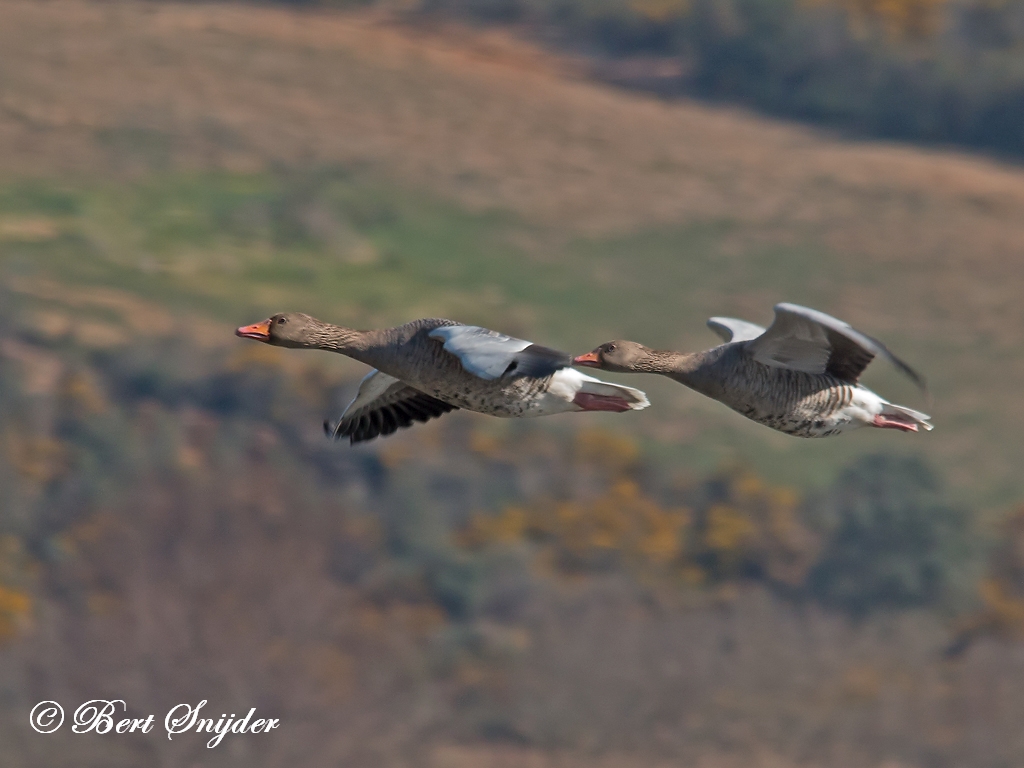Greylag Goose, Grauwe Gans, Graugans, Ganso-comum, Ansar Común
Spotted in the Alentejo region of Portugal. Greylag Goose sound
The Greylag Goose (also spelled Graylag in the United States), Anser anser, is a bird with a wide range in the Old World. It is the type species of the genus Anser.

It was in pre-Linnean times known as the Wild Goose (“Anser ferus”). This species is the ancestor of domesticated geese in Europe and North America. Flocks of feral birds derived from domesticated birds are widespread.
The Greylag Goose is one of the species to which the Agreement on the Conservation of African-Eurasian Migratory Waterbirds (AEWA) applies.
Within science, the greylag goose is most notable as being the bird with which the ethologist Konrad Lorenz first did his major studying into the behavioural phenomenon of imprinting.
The Greylag is the largest and bulkiest of the grey geese of the genus Anser. It has a rotund, bulky body, a thick and long neck, and a large head and bill. It has pink legs and feet, and an orange or pink bill. It is 74 to 91 cm (29 to 36 in) long with a wing length of 41.2 to 48 cm (16.2 to 19 in). It has a tail 6.2 to 6.9 cm (2.4 to 2.7 in), a bill of 6.4 to 6.9 cm (2.5 to 2.7 in) long, and a tarsus of 7.1 to 9.3 cm (2.8 to 3.7 in). It weighs 2.16 to 4.56 kg (4.8 to 10.1 lb), with a mean weight of around 3.3 kg (7.3 lb). The wingspan is 147 to 180 cm (58 to 71 in). Males are generally larger than females, with the sexual dimorphism more pronounced in the eastern subspecies rubirostris, which is larger than the nominate subspecies on average.
The plumage of the Greylag Goose is greyish-brown, with a darker head and paler belly with variable black spots. Its plumage is patterned by the pale fringes of its feathers. It has a white line bordering its upper flanks. Its coverts are lightly coloured, contrasting with its darker flight feathers. Juveniles differ mostly in their lack of a black-speckled belly.
It has a loud cackling call, HOOOOOONK!, like the domestic goose.
This species is found throughout the Old World, apparently breeding where suitable localities are to be found in many European countries, although it no longer breeds in southwestern Europe. Eastwards, it extends across Asia to China. In North America, there are both feral domestic geese, which are similar to greylags, and occasional vagrants.
In Great Britain, their numbers had declined as a breeding bird, retreating north to breed wild only in the Outer Hebrides and the northern mainland of Scotland. However, during the 20th century, feral populations have been established elsewhere, and they have now re-colonised much of England. These populations are increasingly coming into contact. The breeding habitat is a variety of wetlands including marshes, lakes, and damp heather moors.
In Norway, the number of greylag geese is estimated to have increased three- to fivefold during the last 15–20 years. As a consequence, farmers’ problems caused by goose grazing on farmland has increased considerably. This problem is also evident for the pink-footed goose.
The geese are generally migratory, moving south or west in winter. Scottish breeders, some other populations in northwestern Europe, and feral flocks are largely resident. This species is one of the last to migrate, and the “lag” portion of its name is said to derive from this lagging behind other geese.
Other synonyms:
Asturian: Gansu
Azerbaijani: Boz qaz
Bulgarian: siva g”ska
Breton: Ar waz louet, gwaz louet, Waz
Catalan: Oca salvatge, Oca vulgar
Catalan (Balears): Oca salvatge
Valencian: Oca vulgar
Czech: Husa velká
Danish: Grågås
German: Graugans
Greek (Cypriot): ??????????
English: Eastern Graylag Goose, Eastern Greylag Goose, Feral Goose, Gray goose, Gray Lag-Goose, Graylag Goose, Gray-lag goose, Grey goose, Grey Lag-Goose, Greylag, Greylag Goose, Grey-lag goose, Western Graylag Goose
Esperanto: Griza ansero
Spanish: Ansar Comun, Ansar Común, Ánsar Común, Ganso común
Spanish (Argentine): Ganso común
Spanish (Colombia): Ganso Común
Estonian: Hallhani, hallhani (roohani), Hallhani e. roohani, hallhani roohani, Hallhani, roohani, roohani
Basque: antzara hankagorrizta, Oca vulgar
Finnish: Merihanhi
Faroese: grágás
French: Oie cendrée
Friulian: ocje di prât, ocje salvadie
Frisian: skiere goes
Irish: ganso bravo, gé ghlas, Gé mhór fhionn
Gaelic: Gèadh-Glas
Galician: Ganso bravo, Oca vulgar
Manx: Guiy Feie, guiy glass
Croatian: divlja guska, Siva Guska
Hungarian: Nyári lúd
Icelandic: Grágæs
Italian: Oca selvatica
Japanese: haiirogan, Haiiro-gan
Cornish: Gothwyls
Latin: Anser anser
Ladino: aucia salvaria
Limburgish: Grijze gajs
Ladin: Aucia salvaria
Latvian: meža zoss
Macedonian: diva guska
Dutch: Grauwe Gans
Norwegian: Grågås
Portuguese: ganso bravo, Ganso-bravo, Ganso-comum
Romansh: auca grischa
Romanian: gâsca de vara
Russian: Sery Gus, seryj gus
Scots: Geadh glas
Northern Sami: Mearracuonji
Slovak: hus divá
Slovenian: siva gos, siva gosc
Albanian: pata e egër
Serbian: Divlja guska
Swedish: Grågås
Turkmen: boz kaz
Turkish: Boz kaz
Travel Birdwatching Holiday Alentejo, Vacation Portugal for birders to see birds on your trip. Guided Birdwatching Tours & Trips